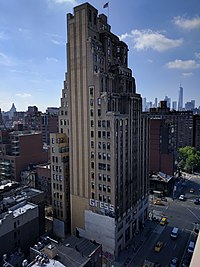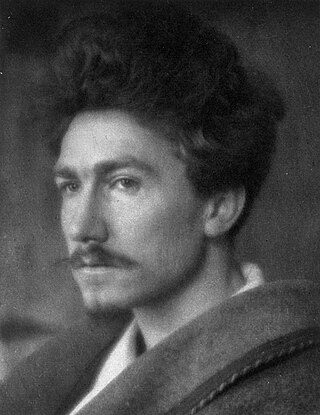
Ezra Weston Loomis Pound was an expatriate American poet and critic, a major figure in the early modernist poetry movement, and a collaborator in Fascist Italy and the Salò Republic during World War II. His works include Ripostes (1912), Hugh Selwyn Mauberley (1920), and his 800-page epic poem The Cantos.

Imagism was a movement in early-20th-century poetry that favored precision of imagery and clear, sharp language. It is considered to be the first organized modernist literary movement in the English language. Imagism has been termed "a succession of creative moments" rather than a continuous or sustained period of development. The French academic René Taupin remarked that "it is more accurate to consider Imagism not as a doctrine, nor even as a poetic school, but as the association of a few poets who were for a certain time in agreement on a small number of important principles".

Lawrence Monsanto Ferlinghetti was an American poet, painter, social activist, and co-founder of City Lights Booksellers & Publishers. An author of poetry, translations, fiction, theatre, art criticism, and film narration, Ferlinghetti was best known for his second collection of poems, A Coney Island of the Mind (1958), which has been translated into nine languages and sold over a million copies. When Ferlinghetti turned 100 in March 2019, the city of San Francisco turned his birthday, March 24, into "Lawrence Ferlinghetti Day".
The Objectivist poets were a loose-knit group of second-generation Modernists who emerged in the 1930s. They were mainly American and were influenced by, among others, Ezra Pound and William Carlos Williams. The basic tenets of objectivist poetics as defined by Louis Zukofsky were to treat the poem as an object, and to emphasize sincerity, intelligence, and the poet's ability to look clearly at the world. While the name of the group is similar to Ayn Rand's school of philosophy, the two movements are not affiliated.
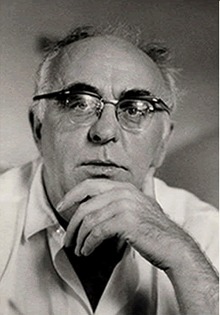
Charles Olson was a second generation modernist American poet who was a link between earlier modernist figures such as Ezra Pound and William Carlos Williams and the third generation modernist New American poets. The latter includes the New York School, the Black Mountain School, and some of the artists and poets associated with the Beat generation and the San Francisco Renaissance.
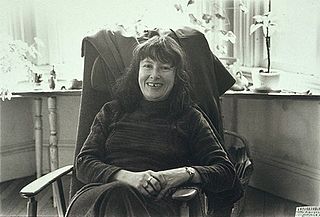
Priscilla Denise Levertov was a British-born naturalised American poet. She was heavily influenced by the Black Mountain poets and by the political context of the Vietnam War, which she explored in her poetry book The Freeing of the Dust. She was a recipient of the Lannan Literary Award for Poetry.

The New American Poetry 1945–1960 is a poetry anthology edited by Donald Allen and published in 1960. It aimed to pick out the "third generation" of American modernist poets, and included quite a number of poems fresh from the little magazines of the late 1950s. In the longer term it attained a classic status, with critical approval and continuing sales. It was reprinted in 1999. As of 2024, Edward Field and Gary Snyder are the only contributors still living.
The Faber Book of Modern Verse was a poetry anthology, edited in its first edition by Michael Roberts, and published in 1936 by Faber and Faber. There was a second edition (1951) edited by Anne Ridler, and a third edition (1965) edited by Donald Hall. The selection was of poems in English printed after 1910, which meant that work by Gerard Manley Hopkins could be included. A later edition was edited by Peter Porter.

James Laughlin was an American poet and literary book publisher who founded New Directions Publishing.
Michael Andre is a Canadian, disc jockey, poet, critic and editor living in New York City.
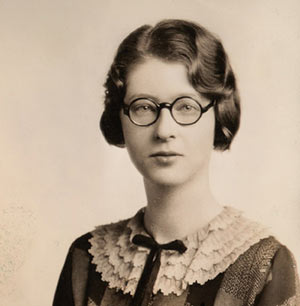
Mary Ethel Barnard was an American poet, biographer and Greek-to-English translator. She is known for her elegant rendering of the works of Sappho, a translation which has never gone out of print.
Nationality words link to articles with information on the nation's poetry or literature.
Nationality words link to articles with information on the nation's poetry or literature.
The Jargon Society is an independent press founded by the American poet Jonathan Williams. Jargon is one of the oldest and most prestigious small presses in the United States and has published seminal works of the American literary avant-garde, including books by Charles Olson, Louis Zukofsky, Paul Metcalf, James Broughton, and Williams himself, as well as sui generis books of folk art such as White Trash Cooking.
Alvin Lustig was an American book designer, graphic designer and typeface designer. Lustig has been honored by the American Institute of Graphic Arts and the Art Directors Club Hall of Fame for his significant contributions to American design.
Richard Lowell Blevins is a poet writing in the tradition of Ezra Pound, H.D., and Robert Duncan, an editor of the Charles Olson-Robert Creeley correspondence, and an award-winning teacher. He was born in Wadsworth, Ohio, in 1950. His undergraduate career was halved by the May 4, 1970, Kent State shootings. He was declared a conscientious objector during the Vietnam War. At Kent State, he studied poetry and the imagination with Duncan and literature of the American West with Edward Dorn. But he has often said that Cleveland book dealer James Lowell was his most formative early influence. He holds degrees from Kent State University, the University of Oregon, and the University of Pittsburgh (Ph.D., English literature, 1985; dissertation on the western novels of Will Henry. He has taught literature and poetry writing at the University of Pittsburgh at Greensburg since 1978, also serving as Humanities Chair for nine years. He is a winner of a Chancellor’s Award, in 1999, the university’s highest recognition for teaching. He previously taught at the University of Akron and Kent State.
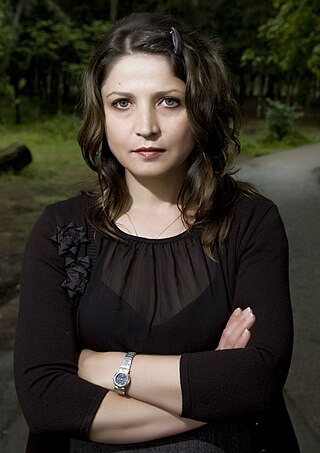
Luljeta Lleshanaku is an Albanian poet who is the recipient of the 2009 Crystal Vilenica award for European poets. She was educated in literature at the University of Tirana and was editor-in-chief of the weekly magazine Zëri i rinisë. She then worked for the literary newspaper Drita (Light). In 1996, she received the best book of the year award from the Eurorilindja Publishing House. In 1999, she took part in the International Writers Program at the University of Iowa. She is the author of four poetry collections, one volume of which has been translated into English: Fresco, available from New Directions. The writer, critic and editor Peter Constantine, in his introduction to Fresco, sums up her style in this way:
Luljeta Lleshanaku is a pioneer of Albanian poetry. She speaks with a completely original voice, her imagery and language always unexpected and innovative. Her poetry has little connection to poetic styles past or present in America, Europe, or the rest of the world. And it is not connected to anything in Albanian poetry either. We have in Lleshanaku a completely original poet."
Martín & Meditations on the South Valley is a semiautobiographical poetry collection or "novel in verse" written by Jimmy Santiago Baca and published in 1987. Contents of the book include an introduction by Denise Levertov,, Martín, an epic poem in nine parts, Meditations on the South Valley, a continuation of Martín in twenty-eight parts, and two glossaries of Spanish words, phrases, and references in English.
Nomad was an avant-garde literary magazine edited and published in Los Angeles between 1959 and 1962 by Anthony Linick and Donald Factor. Linick and Factor were particularly drawn to the poetry and writing of the Beat Generation, who wrote of their own, frequently chaotic, lives.
Gertrude Huston was an American artist and illustrator known for designing book covers for New Directions.
